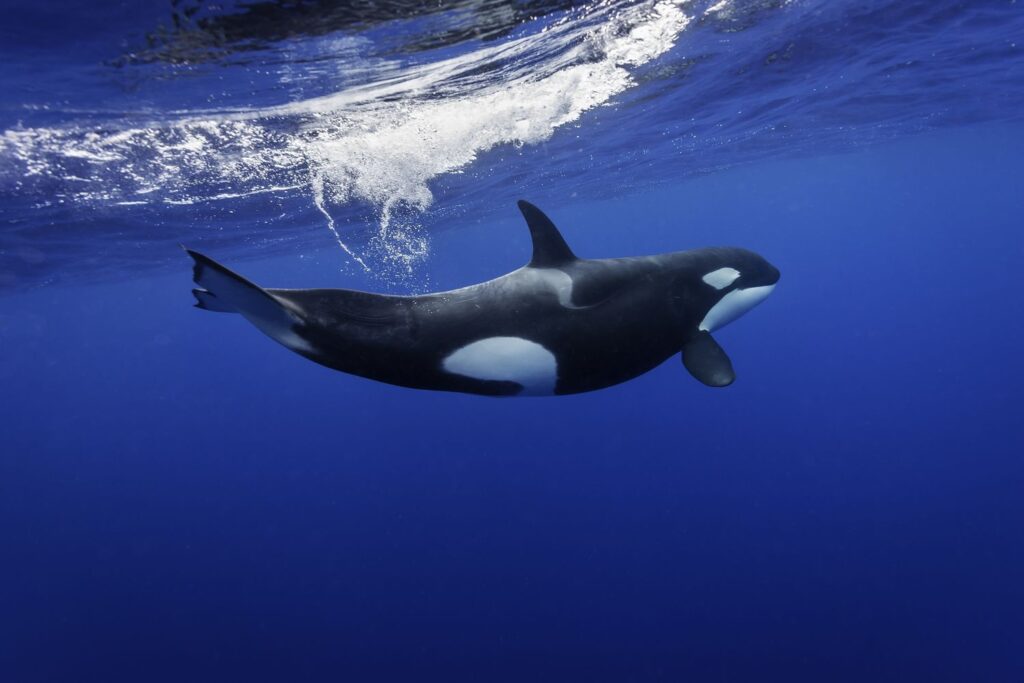
- Orcas are not fish, they are mammals!
Orcas, also known as killer whales, belong to the dolphin family (Delphinidae) within the order Cetacea. While they live in the water and share some physical characteristics with fish, they are warm-blooded, breathe air, give birth to live young, and nurse them with milk.
- Orca Habitat:
Orcas are incredibly widespread, found in all oceans of the world. They can thrive in a variety of water temperatures, from the Arctic to the tropics. They tend to prefer coastal areas near continental shelves and islands, but their range can extend to deep ocean waters as well.
- Orca Predation on Blue Whales (Not Exactly an Attack):
While orcas are apex predators and blue whales are the largest animals on Earth, orcas don’t typically attack adult blue whales. Here’s the breakdown of their hunting behavior:
- Target: Orcas are opportunistic hunters and typically target calves (young blue whales) or even sick or injured adult whales.
- Hunting Strategy: They work in coordinated groups, using their speed and agility to separate a calf from its mother.
- Diet: Orcas have a diverse diet and consume a variety of prey depending on location. Fish, seals, sea lions, and even other whale species (including calves) are all on the menu.
Here are some interesting facts about Orcas:
- Social Creatures: Orcas live in family groups called pods with complex social structures.
- Communication: They use a sophisticated system of vocalizations to communicate with each other.
- Intelligence: Orcas are highly intelligent animals and exhibit complex hunting behaviors.
What are the sizes of Orcas fish?
Orca Size Variations:
Orcas actually exhibit significant size variations depending on their sex and ecotype (different populations with specialized diets and behaviors).
- Males (Bulls): Adult males are typically larger and heavier than females. Their average length ranges from 20 to 28 feet (6 to 8.5 meters) and their weight can exceed 6 tons (5,443 kilograms).
- Females (Cows): Females are generally smaller than males. Their average length falls between 16 to 23 feet (5 to 7 meters) and their weight is around 3 to 4 tons (2,722 to 3,629 kilograms).
- Calves: Newborn orca calves are around 6 to 7 feet (1.8 to 2.1 meters) long and weigh about 400 pounds (181 kilograms).
Largest Orcas:
- Type A Killer Whales (Southern Hemisphere): These are the largest known orca ecotype. Male Antarctic type A orcas can reach lengths of up to 30 feet (9.2 meters).
- Exceptional Sizes: There have been rare documented cases of even larger orcas, with some exceeding 32 feet (9.8 meters) in length.
Interesting Fact:
An orca’s size plays a crucial role in its social structure and hunting strategies. Larger males often lead the pod and are responsible for protecting the group. Their size also allows them to take down larger prey.
That’s a great starting point for exploring the social lives of orcas! Here’s how we can expand on this interesting fact:
Family Pods:
- Strong Bonds: Orca pods are typically made up of close relatives, including mothers, offspring (calves), aunts, uncles, and even grandmothers. These strong family bonds are vital for survival and raising young.
- Cooperative Hunting: Their social structure allows for cooperative hunting strategies. Older, experienced members teach younger orcas hunting techniques, ensuring the pod’s success.
- Shared Responsibilities: Within the pod, there’s a sense of shared responsibility. Orcas take turns caring for young calves, allowing mothers to forage for food.
Complex Social Interactions:
- Communication: Orcas use a variety of vocalizations to communicate, including whistles, clicks, and calls. These vocalizations help them coordinate hunts, maintain social bonds, and even express emotions.
- Dialects: Interestingly, different pods of orcas have been observed to have unique “dialects” within their vocalizations, suggesting cultural variations between groups.
- Sophisticated Behaviors: Their social behaviors extend beyond communication. Orcas have been documented displaying grief, playfulness, and even altruism towards injured pod members.
Understanding Orca Society:
Studying orca social structures helps us appreciate their intelligence and complex social lives. These social bonds are crucial for their survival and contribute to their success as apex predators.
Further Exploration:
- You could mention how orca social structures differ from other dolphin species.
- The transient and resident orca types have varying social behaviors you could explore.




